|
1.
CENTRAL AND WEST AFRICA
Authorised exploitation of kevazingo
The transitional government in Gabon has adopted a draft
decree authorising the exploitation of kevazingo to
"stimulate the development of forest regions," according to
an official statement reported by the media. Harvesting of
kevazingo was suspended in 2018.
The draft decree aims to establish a stricter regulatory
framework for the exploitation of kevazingo. It limits
exploitation to sustainably managed concessions,
strengthens traceability through a geo-referencing system
and requires a CITES permits for finished products.
See:https://www.jeuneafrique.com/1604084/economie-
entreprises/a-la-recherche-de-moteurs-de-croissance-le-gabon-
relance-lexploitation-dun-bois-precieux/
and
https://www.gabonreview.com/retour-conditionne-du-kevazingo-
aubaine-economique-ou-desastre-ecologique-en-devenir/
In other news from Gabon, weather conditions are said to
be unpredictable, particularly in up-country areas. Harvest
levels are below those of last year due to low demand for
some of the redwood species. However, local demand for
okoume remains good but orders for okoume from China
remain low.
Demand from buyes in the Philippines remains steady and
there have been suggestions that demand in Middle East
markets may be recovering with increasing inquiries for
species such as belli, okan, okoume and movingui.
SEEG under provisional administration
The Société d'énergie et d'eau du Gabon (SEEG),
concessionaire for the water and electricity sector in
Gabon, was placed under provisional administration on 27
August according to a decision of the Presidency of the
Gabonese Republic.
Faced with a production shortfall and aging infrastructure
Société d'énergie et d'eau du Gabon (SEEG) is imposing
rotating load shedding to stabilise Libreville's power grid.
The drop in production is mainly due to lower water levels
at the Kinguélé-Tchimbélé dam, an essential infrastructure
for Libreville’s electricity supply.
The dam, which accounts for almost half of the capital’s
energy production, has a deficit of 60 megawatts.
See: https://energynews.pro/en/massive-power-cuts-in-gabon-
seeg-rations-electricity/
The transitional government in Gabon is focusing on road
construction and tackling long-standing issues like the
electricity crisis by building a new hydroelectric dam with
Chinese support. It has been reported in the domestic press
that the Chinese government has pledged investment of
7.2 trillion FCFA for roads, railways and a new port in
Mayumba.
Operators in Cameroon - EU markets remain quiet
Heavy rains have returned slowing harvesting activities
and some mills report a decline in log stocks. The rains are
expected to last until December.
The market in Europe remains dull say operators, while
the Middle East and the Philippines market demand
remains stable. Enquiries from buyers for the Chinese
market are very low but enquiries from Middle East
buyers are said to be improving for species such as iroko,
sapelli and a range of redwoods.
Cameroon President, Paul Biya, recently visited China
where it is reported he secured investment commitments
deals totalling 500 billion FCFA for infrastructure
development among others.
Key projects for the government include Phase 2 of the
Yaoundé-Douala highway, the Edéa-Kribi highway and
the Ngaoundéré-Garoua road.
BRICS countries a significant market
In January this year BRICS expanded to include five new
countries, Egypt, Ethiopia, Iran, Saudi Arabia and the
United Arab Emirates (forming BRICS+). According to a
report by the Cameroonian Institute of Statistics (INS) this
new group is increasingly important to Cameroon’s timber
trade.
The INS reported that over the past five years BRICS+
countries accounted for 29% of Cameroon’s global trade,
with wood products a key component.
See: https://www.businessincameroon.com/public-
management/0609-14120-cameroon-seeks-more-chinese-
funding-for-major-road-projects
Log quota system still in place
Operators in Congo report no harvesting or production
disruptions. Order books are said to be stable for the next
two months. While log exports are officially banned a
quota system is still in place so old log stocks can be
cleared.
Enquiries remain stable with the Philippines continuing to
demand okoume sawnwood. Chinese orders have slowed
and only outstanding contracts are being fulfilled. No
changes in government regulations have been reported and
the focus of government policy is down-stream added
value production.
In the Congo there have been significant investments with
support from China in ministry buildings, up-market
housing projects and road construction. The highly
anticipated Congo River bridge project is another example
of a Chinese contribution.
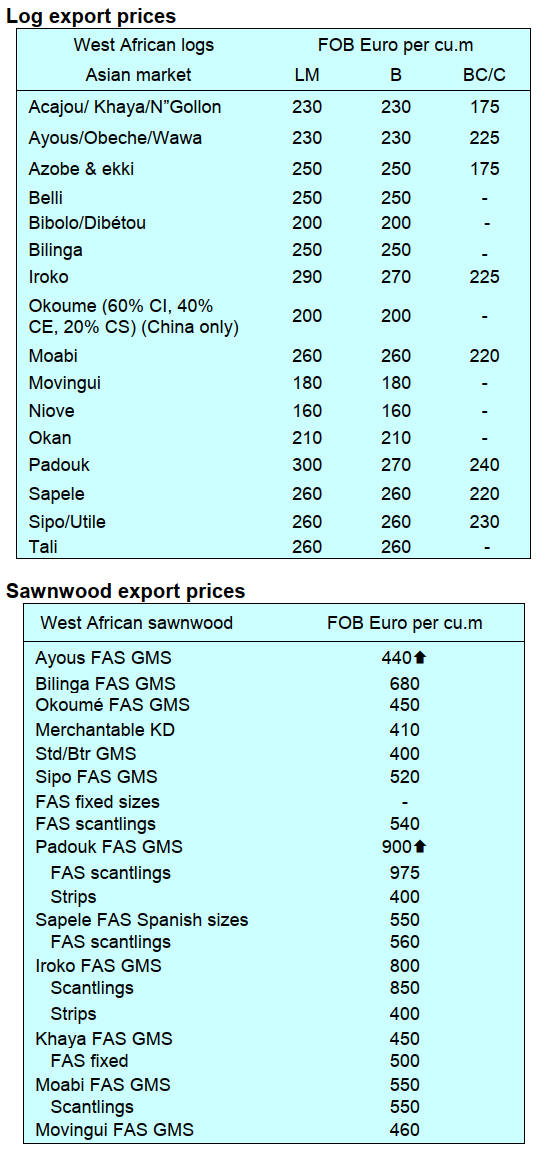
Through the eyes of industry
The latest GTI report lists the challenges identified by the
private sector in the Republic of Congo and Gabon.
See: https://www.itto-
ggsc.org/static/upload/file/20240822/1724289606498649.pdf
2.
GHANA
Demonstrations planned to stop illegal mining
in forest
reserves
Organised labour and some Civil Society Organisations in
Ghana have threatened a series of demonstrations
throughout the country if government does not act to stop
all illegal small-scale mining (known as ‘galamsey’) in
forest reserves and along water bodies.
The media has reported that galamsey activities have
reached crisis proportions in the country where forests are
degraded and water bodies are polluted.
The activists are seeking urgent government intervention
and calling for a ‘state of emergency’ declaration to halt
all mining operatives from activities near forest reserves
and water bodies.
The call for action is led by organised labour, including
the Trades Union Congress (TUC), the Ghana Medical
Association (GMA), the University Teachers Association
of Ghana (UTAG) and the Ghana Federation of Labour,
Other associations include the Peasant Farmers
Association of Ghana (PFAG) and the Ghana Bar
Association (GBA).
The activist group has called on the government to annul
the regulation LI2462, which allows mining in the
country’s forest and withdraw any licenses for prospecting
and mining in forests, protected areas and near water
bodies. The Minister for Lands and Natural Resources,
Samuel Abu Jinapor, has reportedly described calls for a
state of emergency to combat illegal mining as “draconian
and far-reaching.”
The Ghana President, Nana Akufo-Addo, has set up 5-
member ministerial ad-hoc committee to assess how to
deal with the illegal galamsey.
See: https://gna.org.gh/2024/09/organised-labour-demands-
immediate-declaration-of-galamsey-as-an-emergency/
and
https://www.modernghana.com/news/1340742/galamsey-has-
reached-a-crisis-proportion-forest.html
and
https://citinewsroom.com/2024/09/galamsey-declaring-a-state-
of-emergency-draconian-and-far-reaching-lands-minister/
and
https://www.myjoyonline.com/akufo-addo-sets-up-5-member-
ministerial-ad-hoc-committee-to-assess-galamsey-fight/
Exports continue a slow year on year decline
Total wood and wood products export in July 2024 earned
the country Eur10.69 million from a volume of 24,392
cu.m which represented a decrease of 2.6% in value but a
1.5% increase in volume as compared to July 2023
according to Timber Industry Development Division
(TIDD) data.
For the first seven months of the year 2024 cumulative
exports continued to show a year-on-year dip of 12% in
volume and 13% in value against the same period in 2023.

Air and kiln-dried sawnwood and plywood for the regional
market accounted for 56%, 13% and 6% respectively and
accounted for 75% of the total export volume for the first
seven months (157,518cu.m) compared to the 179,456
cu.m in the same period in 2023.
Products that made significant export gains were kiln-
dried boules, briquettes, rotary veneer and teak logs. These
products also recorded positive year-on-year growth in
export values except rotary veneer which dipped by 9.5%
to Eur 2.71milion from Eur 2.47million in the first half of
2023.
The United States accounted for 35% (1,920 cu.m) of
rotary veneer shipments from Ghana’s total export volume
of 5,429cu.m and this earned Eur 944,099 in total export
receipts (Eur 2.7 million).
Canada was the second largest market with rotary veneer
import of 1,101cu.m valued at Eur837,788.
Out of seventy-six (76) exporters recorded in July 2024
the top five were Samartex Timber and Plywood Company
Limited, Multimodal Freight Services Limited, 3RDI
Shipping Agency Limited, Golden Logs Exporters
Limited, and John Bitar and Company Limited. These
enterprises shipped twelve (12) different wood products
including air and kiln-dried sawnwood, billets, plywood
for the regional market and rotary veneer to 35 countries.
Forestry sector contribution to Ghana’s economy
A two-day National Policy Dialogue (NPD) has been held
following a study conducted by the Ghana Statistical
Service (GSS) in collaboration with the Forestry
Commission (FC) to assess the contribution of forestry to
Ghana’s economic development.
Participants at the dialogue included stakeholders from the
forestry industry, GSS, Food and Agricultural
Organization (FAO), the Warnell School of Forestry at the
University of Georgia, the Environmental Protection
Agency (EPA) and the National Development Planning
Commission (NDPC) which deliberated on the theme
“Economic Contribution and Sectorial Linkage of the
Forest Sector to the National Economy of Ghana”.
The GSS identified that the forestry sector contribution
has been underestimated as the informal sector
contribution is possibly under reported, weak reporting
and lack of disaggregated data and linkage between the
forest sector and other economic sector’s contribution to
the national economy.
The GSS report revealed that the country’s forestry sector,
particularly forest and logging in 2014 contributed
GH¢10.83 billion to Gross Domestic Product (GDP),
representing 2.0%. The study also revealed that from 2014
to 2023 the economic contribution of the forest sector to
Ghana’s Gross Domestic Product on the average has been
1.5%.
The Chief Executive of the Forestry Commission, John
Allotey, said the forest sector plays a vital role, not only in
preserving our rich biodiversity but also contribute
significantly to the livelihoods of millions of Ghanaians.
He highlighted on numerous benefits derived from the
forest and expressed his optimism that the discussions and
recommendations brought forth from the dialogue will
shed light on the vital role our forests play as key drivers
of economic growth, employment and national
development and lead to a successful outcome that will
drive the advancement of the forest sector.
See: https://fcghana.org/ce-of-fc-calls-for-collective-
commitment-in-advancing-the-forest-sector/
Business confidence index slips
The latest Monetary Policy Report from the Bank of
Ghana (BoG) has recent surveys indicated some softening
of consumer and business sentiment.
According to the Bank, exchange rate volatilities posed the
biggest challenge to businesses. The Business Confidence
Index dipped to 88.8 from 92.6 in last survey as businesses
expressed concern about the cost implications of the rapid
exchange rate depreciation.
Similarly, the report showed that Consumer Confidence
Index declined to 81.2 in June 2024 from 87.7 in April
2024 on account of high food prices and uncertainties on
future economic conditions.
A statement in the report says “these findings were
broadly in line with observed trends in Ghana’s
Purchasing Managers’ Index (PMI) which fell below the
50.0 benchmark to 49.7 in June 2024, from 51.6 in the
previous month”.
Ghana’s inflation rate for August 2024 dropped to 20.4%,
down from 20.9% in July marking the sixth consecutive
month of decline since March 2024 when it was 25.8%.
See: https://www.myjoyonline.com/business-confidence-dipped-
due-to-rapid-exchange-rate-depreciation-in-may-2024-bog-
report/

Through the eyes of industry
The latest GTI report lists the challenges identified by the
private sector in Ghana.
See: https://www.itto-
ggsc.org/static/upload/file/20240822/1724289606498649.pdf
3. MALAYSIA
Positive indicators for the economy
Bank Negara Malaysia (BNM) has maintained the
overnight policy rate at 3% to support the country’s
economic growth. The Bank’s decision to hold the
benchmark interest rate steady was widely anticipated.
BNM said it will ensure that the monetary policy stance
remains conducive to sustainable economic growth amid
price stability.
On the Malaysian economy, BNM said the latest
indicators point towards sustained strength in economic
activity in the second quarter of 2024, driven by resilient
domestic expenditure and better export performance.
Employment and wage growth, as well as policy
measures, will continue to support household spending.
However, analysts at Kenanga Investment Bank have
suggested demand and prices for wood products in the
local market are likely to remain unchanged in the
immediate to medium term due to economic uncertainty
and higher borrowing costs that continue to dampen new
construction and home building activities.
See:
https://www.freemalaysiatoday.com/category/highlight/2024/09/
05/bnm-keeps-opr-at-3-to-support-economic-growth-2/
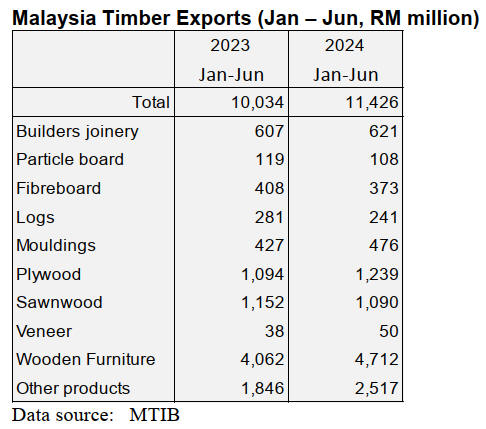
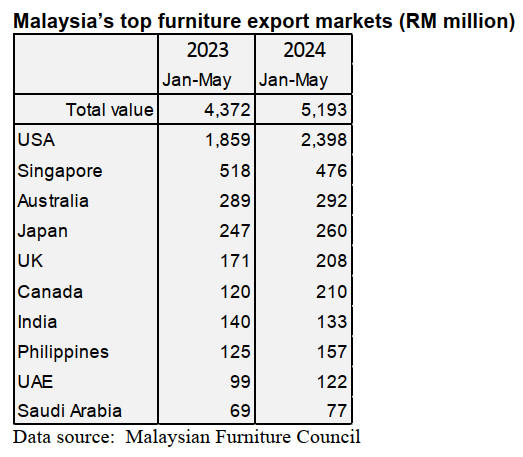
Kenaf industry in Sabah to be expanded
The Deputy Plantation and Commodities Minister, Chan
Foong Hin, said that, through the National Kenaf and
Tobacco Board (LKTN), his ministry intends to expand
the kenaf industry in Sabah through initiatives in
partnership with cooperatives and the private sector.
He added that for 2024 the LKTN has identified 125 ha. of
land in Sabah in the districts of Beluran, Pitas and Sook
with potential for kenaf cultivation. The ministry is
confident that this industry will create new job.
International Furniture Fair, MIFF 2025
The Malaysian International Furniture Fair 2025 is
scheduled to be held from 1 – 4 March 2025 in Kuala
Lumpur. The venues will be at World Trade Centre Kuala
Lumpur (WTCKL) and the Malaysia International Trade
& Exhibition Centre (MITEC). Free shuttle services
between venues will be available.
The organisers say that around 650 furniture
manufacturers and exporters will be exhibiting from
Australia, Cambodia, China, India, Indonesia, Hong Kong,
Japan, South Korea, Taiwan P.o.C, Thailand, Turkey,
Vietnam, UAE and the USA.
See:
http://theborneopost.pressreader.com/article/281556591192658
Sabah’s untouched forests
A two-week survey is underway in the Imbak Canyon
Conservation Area (ICCA) in central Sabah to strengthen
conservation efforts in this area of biodiversity. Over 150
researchers, government officials and conservation
advocates will visit into the 27,000 ha. fully protected
forest reserve to collect data.
The survey follows the expiration of the ICCA Strategic
Management Plan last year which was developed by
stakeholders under the stewardship of Sabah Foundation
and based on findings from a similar survey conducted in
2012.
Sabah Foundation emphasised the importance of acquiring
up-to-date data on the site's natural resources and wildlife,
crucial for the preservation of the area. Imbak Canyon is
one of five conservation areas under Sabah Foundation's
purview, including the Maliau Basin Conservation Area
and the Danum Valley Conservation Area.
Imbak Canyon is one of Sabah's last substantial unlogged
lowland dipterocarp forests in the heart of Borneo. It
serves as a critical water catchment area for Sungai
Kinabatangan, the longest river in Sabah and functions as
a wildlife corridor connecting Danum Valley (43,800 ha)
and the Maliau Basin (58,800 ha).
This sanctuary is home to endangered species such as the
Bornean pygmy elephant, orangutan and clouded leopard.
It also plays a crucial role in forest restoration, acting as a
gene bank for regenerating degraded areas.
In addition to conservation, the survey will explore the
area's potential for tourism development and identify
research questions for future explorations.
See:
https://www.nst.com.my/news/nation/2024/09/1100939/research
ers-survey-one-sabahs-last-untouched-forests
Through the eyes of industry
The latest GTI report lists the challenges identified by the
private sector in Malaysia.
See: https://www.itto-
ggsc.org/static/upload/file/20240822/1724289606498649.pdf
4.
INDONESIA
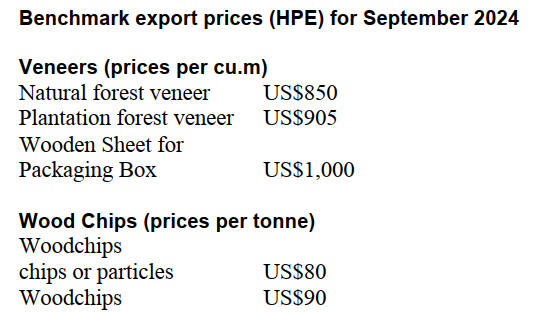
Processed Wood (prices per cu.m)
Processed wood products which are leveled on all four
sides so that the surface becomes even and smooth with
the provisions of a cross-sectional area of 1,000 sq.mm to
4,000 sq.mm (ex 4407.11.00 to ex 4407.99.90)
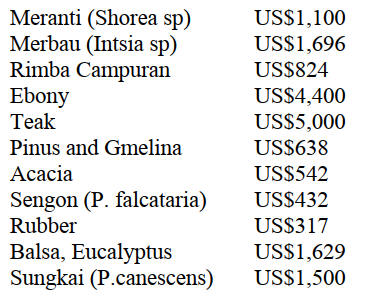
Processed wood products which are leveled on all
four
sides so that the surface becomes even and smooth of
Merbau wood with the provisions of a cross-sectional area
of 4,000 sq.mm to 10,000 sq.mm (ex 4407.11.00 to ex
4407.99.90); US$1,500/cu.m
See:
https://jdih.kemendag.go.id/pdf/Regulasi/2024/1203_Kepmendag
%20dan%20lampiran%20HPE%20dan%20HR%20Produk%20P
ertanian%20dan%20Kehutanan%20Sep%202024.pdf
Upgrading machinery and equipment for downstream
wood product manufacturers - 2nd programme
The Ministry of Industry is preparing for a second
programme of support for upgrading machinery and
equipment for downstream wood product manufacturers.
Putu Juli Ardika, Director General of Agro-Industry at the
Ministry is reported as saying "this programme has three
main objectives: strengthening the value chain in the
processed wood and furniture industry through technology
optimisation, increasing production efficiency in the
sectors and enhancing industrial competitiveness by
improving productivity and production quality”.
He mentioned that the programme implementation is
based on Ministry of Industry Regulation Number 42 of
2022 and Ministry of Industry Regulation Number 31 of
2024. The implementation involves providing discounts or
reimbursement for the purchase of machinery and
equipment. He noted that, as of 27 August 2024, 13
applications had been received through the National
Industrial Information System (SIINas).
The Director of Forestry and Plantation Products Industry,
Setia Diarta, mentioned that as of 2022, a total of 24 wood
processing and furniture companies had taken part in a
programme to upgrade their machinery and equipment.
Based on reports from companies receiving funds this
programme has increased company efficiency by 10-30%,
product quality by 10-30% and company productivity by
20-30%.
See: https://tubasmedia.com/kemenperin-komit-dukung-
pengembangan-industri-kayu-olahan/
and
https://www.tribunnews.com/bisnis/2024/09/02/kemenperin-
siapkan-dana-rp333-miliar-untuk-restrukturisasi-mesin-industri-
kayu
Revitalising the rattan industry
The Ministry of Environment and Forestry facilitated
discussions between raw and semi-finished rattan
producers and advanced processing industries to seek
ways to strengthen Indonesia's rattan industry.
Discussions focused on strategic issues confronting the
rattan processing industry, from raw material sourcing to
finished product production. The meeting also explored
strategies for market creation and efficient management of
the rattan supply chain.
Ristianto Pribadi, Director of Forest Product Processing
and Marketing Management, emphasised that rattan is
abundant in Indonesia and is a sustainable non-timber
forest product. Rattan product exports are a significant for
Indonesia, however, exports declined by over 50%
between 2021 and 2023.
Pribadi noted that the decline in exports negatively
impacted the producers of raw and semi-finished rattan
products.
Indonesia's rattan processing industry faces competition
from other countries, including China, Vietnam, Malaysia,
and the Philippines. Additionally, synthetic rattan products
have posed challenges to Indonesia's rattan marketing.
See: https://en.antaranews.com/news/325155/indonesia-seeks-to-
revitalize-rattan-industry
Vietnam Furniture Association collaboration with
Indonesian businesses
The Vietnam Handicraft and Furniture Association (Ho
Chi Minh City Handicraft and Wood Processing
Association/HAWA) is seeking to collaborate and
cooperate with the Indonesian Furniture and Craft Industry
Association (HIMKI).
The Head of the International Inter-Institutional Relations
Division of HIMKI, Marthunus Fahrizal, welcomed the
suggestion of collaboration from HAWA. He sees this as a
first step in efforts to strengthen the furniture and craft
industry in both countries. He expressed hope for
continued communication efforts so that these aspirations
can be realised. The Indonesian Consul General in Ho Chi
Minh, Agustaviano Sofjan, offered support for the
collaborative efforts between HIMKI and HAWA.
See: https://kumparan.com/kumparanbisnis/asosiasi-furnitur-
vietnam-buka-potensi-kolaborasi-dengan-pelaku-usaha-ri-
23Qz0XAZicx/full
Export of ironwood from East Kalimantan
A Japanese import company has expressed interest in
purchasing finished ironwood products from East
Kalimantan Province. This was conveyed by the company
representatives during their meeting with the Regional
Secretary of East Kalimantan Province, Sri Wahyuni. Sri
Wahyuni noted that the company has been supporting the
planting of ironwood seedlings in Benua Etam for the past
two years.
The Japanese company has shown an interest in buying
ironwood products from local wood entrepreneurs in East
Kalimantan but Sri Wahyuni emphasised that there are
regulations governing its trade.
See: https://kaltim.tribunnews.com/2024/08/22/perusahaan-
jepang-berminat-mengekspor-potongan-kayu-ulin-kaltim.
Egyptians interested in Indonesian agarwood
Two Egyptian companies have shown interest in importing
agarwood products from Indonesia after the Indonesian
Ambassador to Egypt, Lutfi Rauf, hosted a meeting with
several Egyptian buyers.
The buyers explained that the demand for agarwood is for
Grade I which contains oil and Grade II which does not.
When processed the product can meet the requirements of
prayer bead manufacturers and suppliers of perfume raw
materials in Egypt, said the Ambassador.
See: https://harian.fajar.co.id/2024/09/08/buyer-mesir-minati-
kayu-gaharu-indonesia/
Bezos Earth Fund observes social forestry
The Minister of Environment and Forestry Siti Nurbaya
and a delegation from the Bezos Earth Fund recently
visited the Kinipan Village Customary Forest in
Lamandau Regency, Central Kalimantan Province. The
purpose was to observe the efforts of indigenous peoples
in preserving forests and to discuss potential support from
the Bezos Earth Fund for the preservation of customary
forests and the promotion of sustainable management of
natural resources.
Minister Siti expressed her appreciation for the Kinipan
indigenous community's efforts in preserving their
ancestral forests. These forests not only protect
biodiversity but also uphold the community's cultural
traditions.
During the visit, the Bezos Earth Fund delegation
reaffirmed their commitment to supporting conservation
initiatives in Indonesia's ancestral forests through funding
and innovative programmes that prioritise environmental
sustainability.
See: https://ppid.menlhk.go.id/berita/infografis/7855/klhk-ajak-
bezos-earth-fund-lihat-langsung-kemajuan-hutan-sosial
Energy transition key to economic growth
Finance Minister, Sri Mulyani Indrawati, has emphasised
that Indonesia's energy transition efforts are not merely
geared toward environmental protection but are also part
of a long-term strategy to drive economic growth. During
the International Sustainability Forum (ISF) 2024 in
Jakarta she stated that fiscal policy will play a vital role in
supporting the country’s energy transition.
She noted that in recent years Indonesia has issued several
fiscal policy instruments, including green bonds and blue
bonds in both domestic and global markets. These
instruments are designed to secure funding from investors
for environmentally friendly projects, such as renewable
energy development and sustainable forest management.
Indrawati also underscored that Indonesia is one of the
pioneers among developing nations in using fiscal
instruments to fund green projects.
See: https://en.antaranews.com/news/325063/indonesias-energy-
transition-key-to-economic-growth-says-minister
Conclusion of IEU-CEPA negotiations close
Minister of Trade, Zulkifli Hasan, has set a target for
concluding the negotiations for the Indonesia-European
Union Comprehensive Economic Partnership Agreement
(IEU-CEPA). Discussion have beenon going for nine
years.
With the IEU-CEPA in place Indonesian export
commodities entering the European Union would be
exempt from import duties. The agreement is expected to
boost national economic growth. Indonesia has engaged in
similar trade agreements with other countries such as
China and India.
Another advantage of the IEU-CEPA is that it could help
Indonesia avoid the implementation of the European
Union Deforestation Regulation (EUDR). National
industries that will be affected by the implementation of
the EUDR in January 2025 include palm oil, cocoa,
coffee, wood and natural rubber.
See: https://setkab.go.id/en/trade-minister-ieu-cepa-progress-
reaches-90/

5.
MYANMAR
Publication of trade data suspended
Unconfirmed reports say the Ministry of Commerce
(MoC) has reassigned staff in the section publishing trade
data including exports and imports categorised by
commodities. The trade data provided by the MoC is the
most relevant source for researchers and the media.
Currently, there are no other formal sources available
online.
It is unclear why the entire section was reassigned rather
than simply suspending the monthly updates. In a similar
development, the Myanmar Timber Enterprise (MTE) has
stopped uploading the annual harvesting plan and tender
sale results. From 2010 to 2020 MTE worked to improve
transparency and actively participated in the Myanmar
Extractive Industries Transparency Initiative (MEITI)
which suspended its activities in 2021. MEITI withdraw
from Myanmar in 2021.
Although the current government has not conducted any
harvesting for the past three years it is understood that
MTE planned to carry out limited harvesting in this
harvesting season. However, it is learnt that MTE is facing
various challenges, particularly security concerns due to
the weakening security situation. International pressure on
MTE, seen as affecting export revenue, remains a critical
challenge.
Punitive measures against MTE have severely impacted
the timber industry which relies solely on MTE for log
raw materials. Depriving MTE of all sources of income to
deny the authorities access to foreign currency is a
narrative gaining momentum and pushing the timber
industry to the point of collapse.
Thai businesses pulling out
Thai businesses are gradually withdrawing investments
from Myanmar due to its prolonged economic decline,
exacerbated by the COVID-19 pandemic, the 2021
political development and ongoing conflicts.
Siam Cement Group (SCG) has suspended operations and
beverage giant Osotspa has reportedly sold its investments
in two Myanmar subsidiaries. Other Thai companies,
including TPBI Public Company Limited and event
organisers Grand Prix International and Index Creative
Village, have also exited Myanmar.
However, the border trade is still active. Thailand's border
and cross-border trade saw significant growth, with a 22%
year-on-year increase in July 2024 marking four
consecutive months of expansion.
See:
https://www.nationthailand.com/business/investment/40041138 a
nd https://www.nationthailand.com/business/trade/40041207
Internal crisis continues
Since the February 2021 the country has been plagued by
social, political and ethnic turmoil. The conflict has
displaced 3 million people and led to thousands of deaths.
A report by the Special Advisory Council for Myanmar,
an independent advisory group of international experts to
provide an international platform for the democratic
movement in Myanmar, says the government has lost
control over 86% of the country’s townships.
International efforts to resolve the conflict, including
ASEAN's Five-Point Consensus, have largely failed
See: https://specialadvisorycouncil.org/2024/05/briefing-paper-
effective-control-in-myanmar-2024-update/
Overland trade – who in control?
The Institute for Strategy and Policy-Myanmar, a Yangon-
based think-tank, publishes regular reports on the state of
the country with an assessment of the overland trade
between Myanmar and its neighbours.
Among the various statistics in a recent report was the
conclusion that ethnic armed organiszations (EAOs)
opposed to the military are now in control of trade routes
responsible for nearly all of the country’s overland trade
with China.
As the report states, “of the 17 official border trade
stations between Myanmar and its five neighbours India,
China, Thailand, Bangladesh and Laos, resistance groups
now control five: three bordering China (Muse,
Chinshwehaw, and Lwegel), one bordering Thailand
(Mese), and one bordering India (Rihkhawdar).
See: https://thediplomat.com/2024/09/myanmars-border-trade-
with-china-and-thailand-has-collapsed/
and
https://ispmyanmar.com/mp-64/
6.
INDIA
Inflation subdued but
price index for veneers tilts up
The annual rate of inflation based on the India Wholesale
Price Index (WPI) was 2.04% for July 2024. The rate of
inflation in July 2024 was primarily due to increases in
prices of food, manufactured food products, mineral oils,
crude petroleum & natural gas and the group ‘other
manufacturing’.

Out of the 22 NIC two-digit groups for manufactured
products, 13 groups saw an increase in prices and 9 groups
a decrease. Some of the important groups that showed
month on month price increases were chemicals and
chemical products, food products, fabricated metal
products (except machinery and equipment) textiles and
‘other manufacturing’.
Some of the groups that witnessed a decrease in prices
compared to June were basic metals, other non-metallic
mineral products, computers, electronic and optical
products, machinery and equipment and furniture.
The index for wood panels has risen steadily since the
beginning of the year. In July veneer prices rose but the
sawnwood index showed a decline.
See: https://eaindustry.nic.in/pdf_files/cmonthly.pdf
Indian companies face challenges with EUDR
compliance
The EUDR will have significant implications for India’s
woodworking industry according to local trade media
particularly concerning its export markets. India is a
supplier of wooden furniture to Europe and the new
regulation will necessitate substantial adjustments in how
Indian companies source, process and document their
wood product flows.
One of the primary challenges for Indian exporters
will be
compliance with the stringent traceability requirements of
the EUDR.
This requirement will be particularly demanding for Indian
suppliers who often source wood from domestic small
holders where detailed traceability is difficult to establish.
Compliance with the EUDR will likely result in increased
operational costs for Indian woodworking companies.
The EUDR could also encourage broader adoption of
sustainable forestry practices in India. As demand for
sustainably sources wood increases there will be a greater
incentive for Indian forestry operators to adopt sustainable
methods. This shift could have long-term environmental
benefits and improve the overall sustainability of India’s
forestry and woodworking sectors.
Collaboration between the government, industry
associations and international bodies could be crucial in
helping Indian exporters meet the EUDR requirements.
Indian woodworking companies might also look to
diversify their markets to reduce reliance on Europe. Such
a strategy would require comprehensive market research
and development of new trade relationships.
See:
https://woodnews.in/articledetails.php?cat_id=61&scat_id=2006
&art_id=3236
Acceptance of a wideer range of species for veneer
PlyReporter has highlighted a recent shift in log raw
material sourcing by the plywood sector, particularly for
the production of core veneer. The change on the part of
plywood manufacturers has seen the arrival of logs for
core veneer peeling from Uruguay, Australia, Argentina.
There are also reports that import of core veneer from
Vietnam, Tanzania and Brazil is helping to ease the
extreme difficulty in sourcing logs from domestic
resources.
The Plywood industries in States like Gujarat, Rajasthan,
West Bengal, Maharashtra and Andhra Pradesh have been
using imported core veneers and logs. says PlyReporter.
As imported logs become a viable option for core veneer
production plywood production has become more secure
giving a boost to those secondary manufacturers that
utilise plywood as their raw material.
The acceptance of a wide range of species for veneer cores
is good for log exporters and has revitalized port-based
plywood units in India. Ply Reporter says “There are
approximately 160 plywood presses set up in Kandla
region, and all are becoming more active now with
improving imported timber supply scenario”.
Rise in average house prices
In a press release Credai has reported that positive
sentiment among prospective home buyers has resulted in
lifting average house prices by 10% during the first quarter
of 2024.
Each of the top eight cities reported year on year
appreciation of average house prices. In Bengaluru, Delhi
NCR, Ahmedabad and Pune registered double digit
growth was observed.
Although the market appeared the level of unsold
inventory also rose. Notably, Pune led with a year on year
10% rise in unsold inventory followed by Delhi NCR and
Ahmedabad. As of the end of the first quarter 2024 unsold
inventory in the top eight cities stood close to 10 lakh units
with Mumbai Metropolitan Region alone having almost a
40% share.
See: https://www.credai.org/media/view-details/465
GAIN report - increased reliance on imported timber
A June GAIN report from the US Agricultural service says
“ India’s annual import of logs, lumber and wood products
has increased from US$630 million to US$2.3 billion over
the past two decades, with U.S. market share reaching a
record high US$84 million in 2023. Limited domestic
supplies coupled with booming retail furniture, handicraft
and hospitality sectors are driving demand for newer
species. Exporters are also increasingly sourcing imported
species to meet certification requirements in export
markets”.
The Gain report continues “India’s burgeoning
construction, housing, furniture and handicrafts industries
are increasingly relying on imported forest products to
increase output. Government estimates 51 percent of
India’s population will be living in urban areas by 2047,
leading to a demand surge for furniture products. India’s
furniture market is valued at US$24 billion in 2023,
making it the fifth largest producer and fourth largest
consumer globally, with an expected annualised growth
rate of 11 percent from 2023-28”.
India’s construction, housing, furniture and handicrafts
industries are increasingly relying on imported forest
products. Government estimates 51 percent of India’s
population will be living in urban areas by 2047, leading
to a demand surge for wood products.
See: https://fas.usda.gov/data/india-wood-and-wood-products-
update-2024
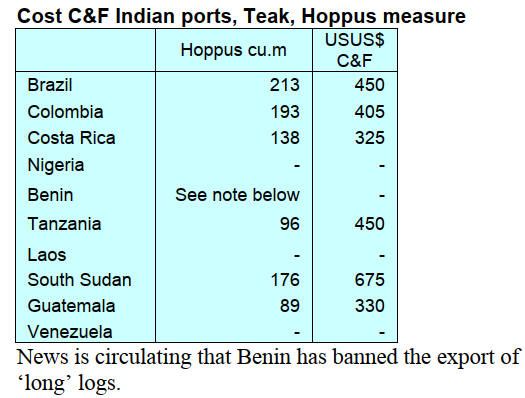
 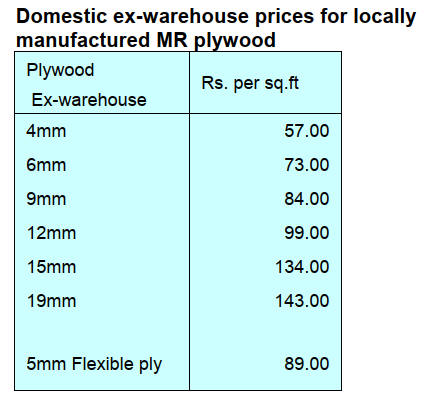
7.
VIETNAM
Wood and wood product (W&WP) trade
highlights
According to Vietnam Customs in August 2024
W&WP exports reached US$1.35 billion, down 2.2%
compared to July 2024 but up 4.5% compared to August
2023. Of this, WP exports were US$931 million, down 5%
compared to July 2024 but up 10% compared to August
2023. Over the first 8 months of 2024 W&WP exports
amounted to US$10.2 billion, up 21% over the same
period in 2023 of which WP exports contributed US$7
billion, up 22% over the same period in 2023.
W&WP exports to Canada in August 2024 were valued
at US$19.6 million, up 3.3% compared to August 2023. In
the first 8 months of 2024 W&WP exports to Canada were
valued atr US$153 million, up 22% over the same period
in 2023.
Vietnam’s exports of living and dining room furniture
in August 2024 earned US$243 million, up 15% compared
to August 2023. In the first 8 months of 2024 exports of
living and dining room furniture brought in about US$1.7
billion, up 23% over the same period in 2023.
Vietnam's W&WP imports in August 2024 stood at
US$270 million, up 3% compared to July 2024 and up
46% compared to August 2023. In the first 8 months of
2024 W&WP imports cost US$1.8 billion, up 27% over
the same period in 2023.
In August 2024 NTFP export were estimated at US$70
million, up 2% compared to July 2024 and up 8% over the
same period in 2023. In the first 8 months of 2024 NTFP
exports amounted to US$547 million, up 13% over the
same period in 2023.
W&WP exports expected to grow between 15 – 18% in
2024
According to the Forestry Department (DOF) WP exports
(mostly high-end/value-added indoor/outdoor furniture)
reached US$5.967 billion, up 22% and other products
(woodchip, woodpellet, wood-based panels) earned
US$2.785 billion, up 21%.
W&WPs from Vietnam went to the US, US$5.019 billion,
up 24%; China, US$1.22 billion, up 38%; Japan, US$949
million, down 2.7%; South Korea, US$472 million, down
1% and the EU US$555 million, up 22%.
Woodchip exports surged by 38% and wooden furniture
increased by 20% compared to the same period in 2023.
Associations and processing enterprises have made efforts
and been proactive in production and market promotion,
says the DOF.
Commenting on the export market Nguyen Liem,
Chairman of Binh Duong Furniture Association (BIFA)
said that high interest rates in many countries are
dampening demand.
Current order book positions for many companies are
short
(just 1–2 months) to fill the reduced inventory rather than
that of 6 months or the whole year.
"Small orders, urgent delivery and reduced purchase
prices
are the common picture of export industries, including the
wood industry", said Nguyen Liem.
However, he said that importer inventories are
decreasing
as global demand for wood products turns up. Following a
difficult period of politic, market, interest rate uncertainties
signs of improvement and recovery appear. He anticipated
Vietnam’s W&WP exports will grow by 15-18%, bringing
in US$15.5-16 billion this year.
According to expert judgement there have been good
signs
in the export markets in the first 8 months of 2024
compared to the same period in 2023. However, it is too
early to state that the markets will be well maintained
throughout the year and be sustainable.
Limited economic growth in major markets, high
inflation,
high credit interest rates as well as the high production and
logistics costs, among others, may hamper Vietnam’s
W&WP exports. In addition, the geopolitical instability
with Russia – Ukraine and the tense in the Middle East
may further negatively affect the supply chain.
W&WP imports in the first 8 months of 2024
Tali (and substitute) imports
Vietnam's tali imports in August 2024 amounted to 28,800
cu.m, worth US$11.3 million, up 3% in volume and 3% in
value compared to July 2024 and compared to August
2023, imports increased by 45% in volume and 48% in
value.
In the first 8 months of 2024 imports of tali are estimated
at 193,000 cu.m, worth US$74.2 million, down 27% in
volume and 33% in value over the same period in 2023.
Tali (and substitute) log and sawnwood imports
In the first 7 months of 2024 the volume of tali logs
imported into Vietnam was 90,700 cu.m, worth US$30.9
million, down 25% in volume and down 30% in value
over the same period in 2023. Imports of tali sawnwood
stood at 74,300 cu.m, worth US$32.2 million, down 41%
in volume and 45% in value over the same period in 2023.

Tali suppliers
In the first 7 months of 2024, tali imports from major
suppliers decreased against the same period in 2023, while
imports from China, Singapore, Cambodia, UAE rose.
In particular,̉ tali imports from Cameroon fell by
36% in
volume and 41% in value over the same period in 2023,
reaching 109,600 cu.m, worth U$42.7 million and
accounting for 67% of total imports.
Imports of this wood from the Congo amounted to
18,500
cu.m, worth US$7.1 million, down 15% in volume and
down 29% in value over the same period in 2023.
In addition, tali imports from some other markets
decreased year-on-year, such as from Gabon down 33%;
from Nigeria by 29%; from Laos by 47%; Ghana by 31%;
from Equatorial Guinea by 817%; from Hong Kong by
92%.
In contrast imports of tali from China surged by
242%
over the same period in 2023, reaching 8,300 cu.m as well
as from Singapore reaching 1,040 cu.m; and from
Cambodia reaching 884 cu.m.
Wood industry seizes opportunities to achieve
US$15.2 billion export target
Vietnam's W&WP exports are expected to boom in the last
months of this year with a growth rate of over 20% amid
positive signs of recovery in most markets.
“The export market for timber and wood products is
seeing
positive recovery signals, particularly in the main export
products, including wood chips, which have increased by
nearly 38% and timber and wood products, which have
risen by over 20% year-on-year,” according to the Director
of the Forestry.
Vietnam's wood and forestry sector aims to export
$15.2
billion this year, an increase from $14.47 billion last year.
However, experts believe that to achieve this target the
wood industry will face many obstacles.
Since the slowdown in 2023 from the beginning of
this
year wood and forestry processing associations and
enterprises have been proactive in production and seeking
export markets.
A series of market exploration fairs were held,
attracting
customers’ interest in Vietnamese wood products.
Lê Minh Thiện, chairman of the Bình Định Timber and
Forest Products Association, said if wood industry
businesses comply well with the EUDR it will enhance
their competitiveness in the EU and the penetration of
wood products into this market will increase significantly.
However, if companies fail to meet the EUDR
requirements their goods will face difficulty entering the
EU market.
Regarding solutions for the Vietnamese wood
industry, Chairman of the Việt Nam Timber and Forest
Products Association Đỗ Xuân Lập said that businesses
need to focus on improving competitiveness based on five
main pillars. It includes improving production techniques
and using technology, emission reduction, trade promotion
and building internal monitoring standards.
Chairman of the Bình Dương Wood Processing
Association (BIFA) Nguyễn Liêm assessed that the recent
strong growth in wood and wood product exports is a
positive outcome for Vietnam’s wood industry amid many
difficulties.
“However, to grow and develop sustainably wood
industry
enterprises need to proactively adapt to all conditions and
circumstances, thereby making flexible changes in
production, business and export processes. The
development of technology and the supply chain for
products, from raw materials to logistics, is very critical,”
he added.
See: https://vietnamnews.vn/economy/1662453/wood-industry-
seizes-opportunities-to-achieve-15-2-billion-export-target.html
Vietnamese wooden cabinets: US concludes
investigation
The Trade Remedies Authority (Ministry of Industry and
Trade) of Vietnam announced that the US Department of
Commerce (DOC) has finalised its investigation into anti-
dumping and anti-circumvention measures on wooden
cabinets imported from Vietnam.
The DOC upheld its preliminary findings from September
2023, determining that three types of Vietnamese cabinets
with components made in China are subject to existing
duties on Chinese products. However, the broader
investigation into anti-circumvention duties was canceled.
Vietnamese exporters must use a self-certification
mechanism and provide documentation to avoid anti-
dumping and countervailing duties.
This documentation must be maintained for five years for
potential verification by U.S. authorities.
The DOC will notify U.S. Customs and Border Protection
to implement this self-certification regime, which excludes
Vietnamese products not falling under the specified
categories from duties.
The investigations were initiated by the DOC in May and
June 2022, with existing anti-dumping and countervailing
duties on Chinese cabinets ranging from 4.37% to
262.18% and 13.33% to 293.45%, respectively.
See: https://vietnamwood.com.vn/u-s-cancels-investigation-
vietnam-wooden-cabinets/
8. BRAIL
Biome restoration in the Atlantic Forest
The Brazilian Forest Service (SFB) has signed its first
Federal forest concession contract in the Atlantic Forest
biome covering over 3,000 hectares in the Irati National
Forest in the State of Paraná, southern Brazil.
The project wil undertake restoration by replacing exotic
species with native species like araucaria (Araucaria
angustifolia), tree fern and imbuia (Ocotea porosa). The
contract, signed with the company Ibema Participações
S.A., will run for 35 years and includes phases for forest
restoration followed by the potential commercial use of
the planted forests.
In addition, the forest concession allows the use of carbon
credits as supplementary revenue and it is part of the
Investment Partnerships Program (PPI) with support from
the Ministry of the Environment and Climate Change
(MMA), the National Bank for Economic and Social
Development (BNDES) and the Chico Mendes Institute
for Biodiversity Conservation (ICMBio).
See: https://forestnews.com.br/servico-florestal-assina-1o-
contrato-de-concessao-na-mata-atlantica/
Amazon drought disrupts forest regeneration
A study conducted by EMBRAPA (Brazilian Agricultural
Research Corporation) has revealed that continuous
droughts have delayed the replenishment of timber stocks
in managed forests in the Amazon by 20 years, extending
the regeneration cycle from 25 to 45 years.
The research, carried out over a 600-hectare in the
municipality of Lábrea (Amazonas State) from 2000 to
2022 indicated that climatic events such as El Niño
increased tree mortality and negatively affected forest
recovery process. Initially it was expected that the forest
would recover within 25 years, however, recovery has
been slower due to reduced rainfall and extended droughts.
The results of evaluations corroborate findings from
previous studies conducted in the forests of Acre State in
the Amazon Region and other tropical forests which have
shown that tree mortality is associated with climatic
events.
The study highlights the need for further
investigations
into the influence of climate change on forest regeneration
and which commercial timber species are most vulnerable.
The information generated by the study will be compiled
into a database, currently under construction, which will
be made available to research institutions, forestry
professionals and other interested parties through
Embrapa's Research Data Repository (Repositório de
Dados de Pesquisa da EMBRAPA - Redape).
See: https://forestnews.com.br/secas-atrasam-em-20-anos-a-
reposicao-de-estoques-de-madeira-em-floresta-manejada/
Woodtrade Brazil – focus on export opportunities
The 5th Woodtrade Brazil 2024 was held 16 September in
Curitiba and addressed trends and opportunities in the UK
and US markets, underlining Brazil's role as a global
timber and timber products supplier.
The event included two foreign organisations, the UK
Timber Trade Federation and the US National Wooden
Pallet and Container Association (NWPCA). The UK
Timber Trade Federation will provided an analysis of
current trends as well as perspectives and opportunities for
the Brazilian timber industry in the British context.
Meanwhile, NWPCA focused on the American pallet and
packaging market.
Brazil is a significant global supplier of wood exporting a
range of products including plywood, sawnwood,
mouldings, pellets, flooring, doors and pallets. Major
export markets include the United States, the European
Union and the United Kingdom.
Woodtrade Brazil Fair is organised by the Brazilian
Association of Mechanically Processed Wood Industries
(ABIMCI) in partnership with the Federation of Industries
of Paraná (FIEP) and Malinovski and is part of the
International Wood Week (SIM). This also includes the
Lignum Latin America Fair and other related events which
will deliver technical content, innovations, trends and
emerging technologies that are shaping the future of the
timber industry.
See: https://abimci.com.br/mercados-estrategicos-para-a-
exportacao-de-produtos-madeireiros-do-brasil-sao-destaque-no-
woodtrade-brazil-2024/
Sustainable production of timber from natural forests
The forest sector in the State of Mato Grosso, a major
timber producing state in the Amazon Region, stands out
for its sustainable practices in timber production from
natural forests.
Forest News reports exporters who invest in sustainable
forest management and technologies to minimise
ecological impacts are gaining recognition, especially in
demanding international markets such as Europe and
North America, along with Asian markets. These three
main international markets accounted for 54% of Mato
Grosso’s forest product exports in 2024, generating
US$23.5 million in the first seven months of this year
according to the Ministry of Agriculture and Livestock
(MAPA).
Forest News writes “sustainable practices have added
value to wood products and positioned manufacturers in
the State as a benchmark for protecting the Amazon and
responsible economic development. Forest-based
companies have sustained their operations and gained new
markets that demand and prioritise products with
traceability and environmental responsibility, pillars of the
future of the forest sector”.
See: https://forestnews.com.br/exportadores-de-madeira-nativa-
em-mato-grosso-se-destacam-por-producao-sustentavel/
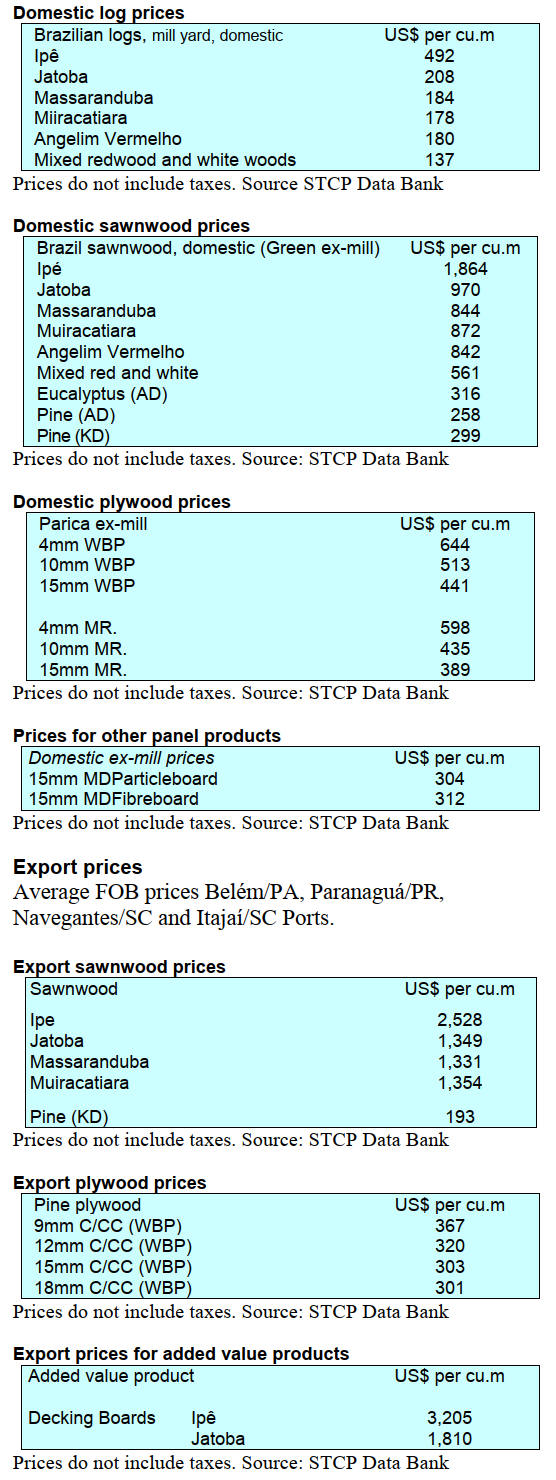
Through the eyes of industry
The latest GTI report lists the challenges identified by the
private sector in Brazil.
See: https://www.itto-
ggsc.org/static/upload/file/20240822/1724289606498649.pdf
9. PERU
Ucayali - more than 800
forest fires
The Forest and Wildlife Service (SERFOR) has reported
that in Ucayal,i so far this year, around 840 forest fires
have been reported. During the first and second week of
September, every dawn the city wakes to a haze of smoke
due to nearby forest fires.
The departmental commander of the Ucayali Fire Service
reported that in August alone 46 emergencies were
attended mainly in the districts of Campo Verde and
Nueva Requena, areas prone to fires due to high
temperatures and dry vegetation.
This increase in fires coincides with the alert issued by the
National Meteorological and Hydrological Service of Peru
which warned of an increase in hot spots in the Amazon
region.
The commander of the Ucayali fire Service explained that
the main cause was the uncontrolled burning of fields, a
common practice among local farmers to prepare their
land. "The fire easily gets out of control due to the strong
winds and dry vegetation.
According to the Director of monitoring and evaluation of
natural resources at SERFOR an alarming 98% of forest
fires in Peru are caused by human action. "The country has
recorded more than 2,500 forest fires so far this year,
affecting not only people's lives, but also the essential
ecosystem services that nature provides, he said.
OSINFOR cooperation with Honduras
The Forest and Wildlife Resources Oversight Agency
(OSINFOR) uses a technology that alerts the authorities
when cases are identified that affect the sustainable use of
forest resources. Within the framework of the South-South
and Triangular Cooperation Project OSINFOR is
transferring this technology, called Forest Alerts, to
Honduras to be adopted in the country.
This initiative is an important step in consolidating the
efforts of both countries to conserve their natural resources
and combat illegal activities that threaten their forests and
reaffirms the commitment of Peru and Honduras in the
fight against environmental crimes.
See: https://www.gob.pe/institucion/osinfor/noticias/1017547-el-
osinfor-transfiere-a-honduras-mecanismo-de-alertas-para-
combatir-delitos-forestales-y-fortalecer-la-gestion-de-los-
bosques
In related news, within the framework of the work plan
established with regional governments OSINFOR
transferred a national methodology for the study of the
index and percentage of illegal logging and timber trade to
Loreto with the aim of replicating it in this Amazon
Region. This will allow the regional forestry authority to
make more effective decisions in the fight against illegal
logging.
OSINFOR will provide technical assistance throughout
the process comprising representatives from the eight
Provinces of Loreto with the support of the National
University of the Peruvian Amazon (UNAP), the National
Forest and Wildlife Service (SERFOR) and the technical
and financial support of the USAID FOREST+ program
and the United States Forest Service.
See: https://www.gob.pe/institucion/osinfor/noticias/1021037-el-
osinfor-transfiere-a-loreto-metodologia-para-medir-y-hacer-
frente-a-la-tala-ilegal
 
|